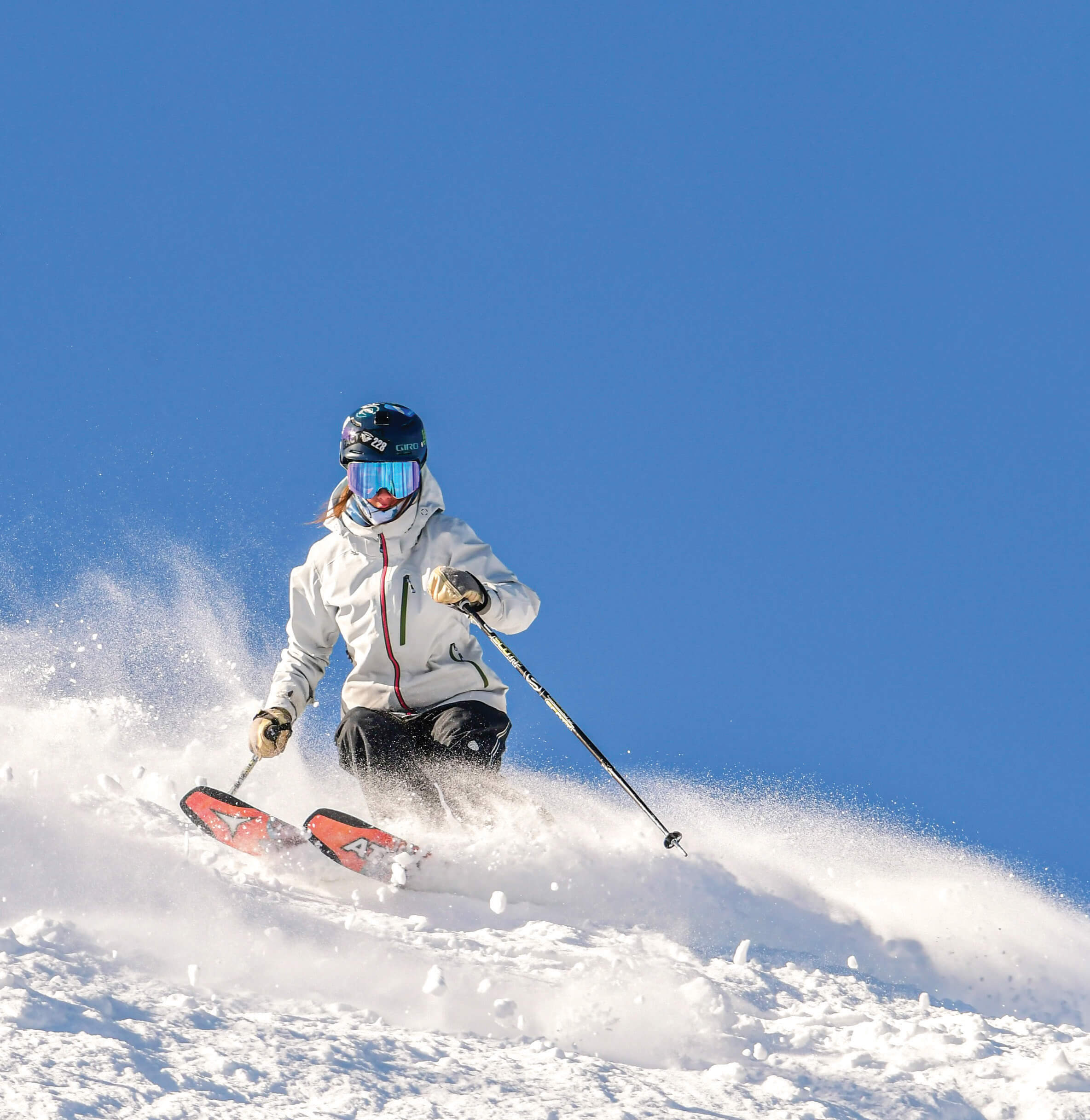
24 Nov Freeride
When 18-year-old Canadian freeskier Marcus Goguen stood in the starting gate at last year’s Freeride World Tour stop in Kicking Horse, British Columbia, many spectators held their breaths. The reigning Freeride Junior World Tour champion was coming off a ninth-place finish at his professional debut in Spain a few weeks earlier and now was on his home turf, ready to put down what he hoped would be a winning run.
Less than a minute later, after spinning a massive 360 and throwing a huge backflip off a rocky cliff, Goguen was in first place. He held on for a second-place finish and came in ninth overall in the final season rankings, the youngest in a field of older, more experienced skiers. “I couldn’t have asked for anything better, honestly,” Goguen says. “I never expected to get on the tour as an 18-year-old.”
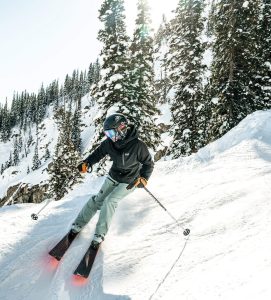
A skier approaches a feature on the Toilet Bowl run at a freeride competition at Jackson Hole Mountain Resort.
Goguen, now 19, honed his skills by competing in junior competitions through the International Freeskiers and Snowboarders Association (IFSA), a worldwide organization dedicated to promoting the sport of freeriding — basically skiing or snowboarding down from the top of a mountain on natural, ungroomed terrain. With a maximum score of 100, athletes earn points based on line choice, technique, control, fluidity, air, and style. The IFSA sanctions events for athletes ages 12 to 18; Goguen won the Junior World Championships in 2023 at age 18 before he turned pro.
The Rocky Mountains are home to a growing number of junior freeriders. Thousands of young athletes compete each year at venues like Jackson Hole, Big Sky, Grand Targhee, Whitefish Mountain, Bridger Bowl, Schweitzer Mountain, and more. Each competitor has the same dream as Goguen: to make it to the Freeride World Tour and stand among the world’s elite professional skiers and snowboarders in a sport that is quickly becoming one of the most popular and exciting events on snow.
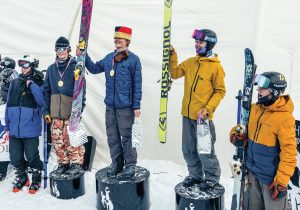
Boys in the 15- to 18-year-old category take the podium at the Jackson Hole freeride competition. Photo by CONNOR BURKESMITH
Most skiers remember Shane McConkey as a free-spirited, extreme-skiing pioneer with a wild and often silly side. After a stint on the pro mogul tour, McConkey won the North American Freeskiing Championship in 1995 and never looked back. His stories from the early days are those of legends, unbelievable tales of mind-boggling feats on snow, many of which had never been done before. McConkey, who died in 2009 during a BASE-jumping accident, is also credited with creating the first reverse-camber powder ski, revolutionizing and revitalizing the ski industry along with it. McConkey wanted freeskiing to be taken seriously, so he founded the International Freeskiers Association in 1996 to sanction adult competitions around the globe. Today, McConkey’s vision lives on and has evolved into the IFSA, which added junior events for the 2012 season and now governs more than 3,500 young athletes between the ages of 12 and 18, hailing from places all around the world.
The nonprofit IFSA sanctions events in North and South America, although each participating resort runs its own competition. For the 2023 season, which culminated in April, there were 97 junior events — a tremendous increase from the first season 11 years ago when there were just 16 competitions. Most are held in the western U.S. and Canada, but a few occur at some of the bigger East Coast ski areas and in South America during the summer. Resorts that host these competitions — separated into regional- and national-level events — are generally big mountains known for steep, difficult terrain. Athletes earn points throughout the season, hoping to snag a spot in the North American Junior Championships held in April at a different resort each year.
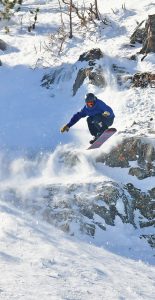
Bridger Bowl Freeride Team member Harrison Hoffman catches air on the course at a junior competition at Big Sky Resort. CRYSTAL IMAGES PROFESSIONAL PHOTOGRAPHY/WILL BARKER
Wallace Casper, head coach of Montana’s Big Sky Ski Education Foundation’s Freeride Team, has seen firsthand how the sport has exploded around the region. He chalks it up to one word: fun.
“Freeride is awesome because the sport is basically a combination of many different disciplines of skiing and snowboarding,” Casper says. “An athlete needs alpine, mogul, and freestyle skills to succeed. One of the best parts is that athletes get to choose their path down the mountain, allowing for a lot of creativity. It’s just super fun.”
Casper’s Big Sky-based team has had a lot of success over the past few years. During the 2023 season, Kennedy Cochenour placed first and Kira Livernois placed fourth in the 12- to 14-year-old girl’s category. Hayes Livernois finished second in the 15- to 18-year-old boy’s skiing category, and Elijah Singer took first place in the 15- to 18-year-old boy’s snowboarding division.
Casper, who competed in IFSA junior events while growing up in Utah and is also IFSA’s northern regional director, is proud of the Big Sky crew’s accomplishments. “Our team has produced some of the best athletes in the country over the past few seasons,” he says. “It’s awesome to watch the kids develop their skills over the years they are with us.”
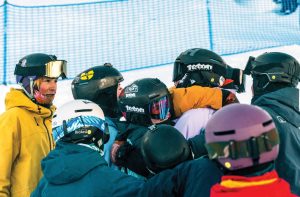
Freeride athletes are known for their camaraderie, and often surround each other at the finish gate. Photo by CONNOR BURKESMITH
Further south in Jackson Hole, a region home to well-known freeriders like Travis Rice, Tim Durtschi, and Lynsey Dyer, there is a similar sentiment from Collin Rehm, the freeride program director for the Jackson Hole Ski and Snowboard Club. “The thing that separates freeride kids from the rest is how much fun they’re having while doing it,” he says. “There’s so much momentum right now, and the kids are really excited about it.”
It’s no surprise that the sport is seeing explosive growth with younger skiers and riders. It combines the freestyle elements seen in resort terrain parks (spins, grabs, big airs) with the kind of skiing they do with their friends. Although freeride is technically an individual sport, it’s built on the idea of community and teamwork. “Freeride is a discipline that adds just enough structure so that the athletes can push themselves and see real results and improvement,” Rehm says. “The kids are always giving each other information about conditions and line choice and are hyping each other up in the start gate. Everybody wants to see everybody else do their best, and while it’s still competitive, the success of one athlete is felt by the whole community.”
Freeride snowboarder Harrison Hoffman, 16, rides for the Bridger Bowl Freeride Team near Bozeman, Montana, and finished fifth overall last season. Hoffman attributes the sport’s rise in popularity to the ski film industry and professional riders inspiring younger generations to treat the entire mountain as a terrain park. “Freeride offers a unique outlet for kids to be as creative as they can possibly be,” says Hoffman. “There’s really no limit to what you can do in this sport, and it is truly something you cannot experience in any other ski or snowboard discipline.”
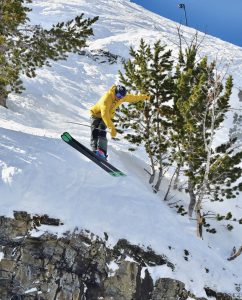
Jackson Hole-based skier Simon Karroum tweaks his air during a junior competition at Big Sky Resort. CRYSTAL IMAGES PROFESSIONAL PHOTOGRAPHY/WILL BARKER
Today, junior freeriders have even more to look forward to with the recent acquisition of the Free-ride World Tour (FWT) by the International Ski and Snowboard Federation (FIS). FIS is the highest governing body for skiing and snowboarding — from alpine and Nordic to big air and moguls — and the merger will help the freeride sport gain a future place in the Winter Olympics. IFSA will remain an independent organization and continue to develop junior freeriders, acting as a pipeline to the FWT.
“Integrating FWT will see FIS add one of the most exciting, dynamic winter sports competition formats to its portfolio,” said FIS president Johan Eliasch in a press release after the acquisition was announced in 2022. “This is truly a win-win for all parties as FIS can bring massive growth potential to the FWT, providing the chance to develop on a broader stage. FWT brings a highly professional tour that offers breathtaking action and an entirely new element of skiing and snowboarding to FIS.”
As a response to these changes, the Big Sky Ski Education Foundation recently started a program for athletes over the age of 18 who have grown out of the junior events but still want coaching to try and qualify for the adult FWT competitions. Casper feels that these changes will offer more opportunities for his young athletes. “The [merger] will bring a lot of exposure to the sport,” he says. “Freeride is heading toward the Olympics.”
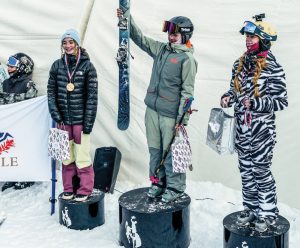
The girls in the 12- to 14-year-old category take the podium at Jackson Hole. Photo by CONNOR BURKESMITH
With all of this growth, the 2024 winter will see more freeride events around the region than ever before. Resorts are eager to capture the opportunities that hosting these competitions can bring. The events often draw hundreds of participants — mostly families — who typically stay for several days. They also help put the resorts on the map in the freeride community, making them a must-stop for intrepid skiers and snowboarders who want the thrill of skiing steep alpine faces. The competitions make for excellent spectating, too, and just an all-around good vibe on the mountain.
“The growth of junior freeride skiing has had a very positive impact on the resort, both from a community standpoint as well as a spectator opportunity,” says Liv Grubaugh, senior manager of brand experience at Big Sky Resort. “We are always honored to host both regional and national competitions and are excited by the energy that the athletes and their families bring to the mountain.”
Casper echoes these sentiments, pointing out that the sport’s origins are all about having fun within a close-knit community of skiers and riders.
“Some of the best memories I’ve had at [freeride] events have been outside the competition itself,” he says. “Meeting incredible skiers from all around the country and shredding with them before and after the competition is sometimes the best part of the trip. I’ve made dozens of lifelong friends through the sport, and I hope the kids I coach can have the same experience.”




No Comments